Hands On with ASUS ROG Avalon: A Teardown Video
by Ian Cutress on September 2, 2016 7:00 AM EST- Posted in
- desktops
- Systems
- Motherboards
- Asus
- ROG
- Trade Shows
- Computex_2016
- Video
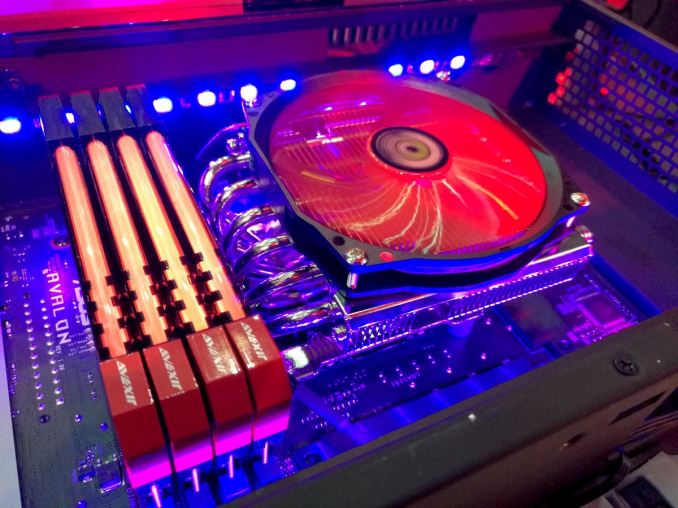
During Computex 2016, as part of their 10-Years of the Republic of Gamers’ celebrations and showcase, ASUS surprised me with a new take on the PC: the ROG Avalon. The Avalon is still a very extensive work in progress, however the fundamental concept is highly intriguing for anyone interested in PC design – using custom form factor parts and fitting them into a dedicated chassis but still opening up the options for users to customize their build. We were able to grab the hardware and Johnathan Chu, Product Manager for motherboards at ASUS, for a short time to record a video for a quick teardown and analysis.
Apologies for the audio, it was an impromptu recording with no equipment apart from a smartphone.
Project Avalon
Section taken from our Computex 2016 Coverage
When you’ve been reviewing and testing motherboards, as well as shouting at certain engineers for absolutely nonsense ideas (or really good ones), there is somewhat a monotony to it all. One generation there’s a new feature from one manufacturer, and the next generation we see it on mostly all the others. Some features are special and aren’t copied, but these require larger amounts of R&D and investment, then require the PR teams to communicate why the new feature is good or not.
One interesting conversation I had a couple of years ago was regarding the future of motherboard form factors. It was then as we see now: the full sized ATX, micro-ATX and mini-ITX systems accounted for 99%+ of desktop class PCs. Some large OEMs had their own designs on desktops, Zotac has a number of small mini-PCs for various markets, and servers do all sorts of standard and non-standard sizes, but for the consumer, it is essentially all about those three (and mini-STX is now moving in that space). So a couple of years ago, when the initial talk of Steam machines was coming to play, ASUS asked me what I thought about non-standard motherboard sizes in desktop sized systems.
It should be clear to most that the motherboard size issue is a chicken/egg situation. When Intel designs a CPU, there are certain limitations to where everything should go. Or no, I will correct that – there’s a budget limitation to where things can go. For example, memory is often to a certain side of the CPU because that provides the best quality signal for the onboard traces. Technically it can go on a different side (as it does on some designs), but that often requires more motherboard PCB layers to ensure the signal does not degrade or interfere with other signals, and in most cases there is a performance/latency penalty if you have to put it further away. But in order to stay buoyant, a motherboard manufacturer will stick to the appropriate design, because guess what – all the cases use the same standards too. The minute you produce a novel motherboard design, such as a different IO position or a new method for storage, none of the current cases on the market will work with it. So the case manufacturers can’t change because there are no products in a new design, the motherboard manufacturers can’t change because of the lack of cases but also the cost, and Intel keeps it consistent to keep everyone in the chain happy. Hello chicken, meet egg. Hello egg, meet chicken.
The only way to do a custom form factor is to build the system completely yourself, which is what Zotac does. Zotac plays mainly in the mini-PC market, and their owner Partner (‘Manufacturer of motherboards, AGP cards and other consumer electronics’ on their Google Search) has long fingers into manufacturing for other big name brands, so integrating the Zotac brand into new designs with custom chassis is easy enough. However ASUS wanted to go bigger and better, and that is how systems like the G20, a full desktop with a custom design, and the GR8, a book-sized Steam machine, came about. But it was clear, ASUS wanted more. Insert Project Avalon.
Project Avalon
Project Avalon is a custom, high-performance, gaming/VR PC design from ASUS. It is still very early in the design cycle, to the extent that this chassis currently weighs almost 40 lbs, but the concept is there. Inside is a custom designed motherboard that uses various internal connectors to implement various features. The design as it stands is built for Skylake plus a single GPU, and enough space to operate liquid cooling. The Perspex window on the top is so users can see into the design, flashing lights and all.
Astute readers will note that the PCB design looks rather odd – there isn’t a PCIe slot here, no power delivery, no rear IO, and what looks like the rear of a 24-pin power connector on the left-hand side. All we needed to do was take the motherboard out:
On the top we have a CPU socket, some memory slots, an M.2 slot, and what looks like a number of connectors for daughter boards. If we flip it over:
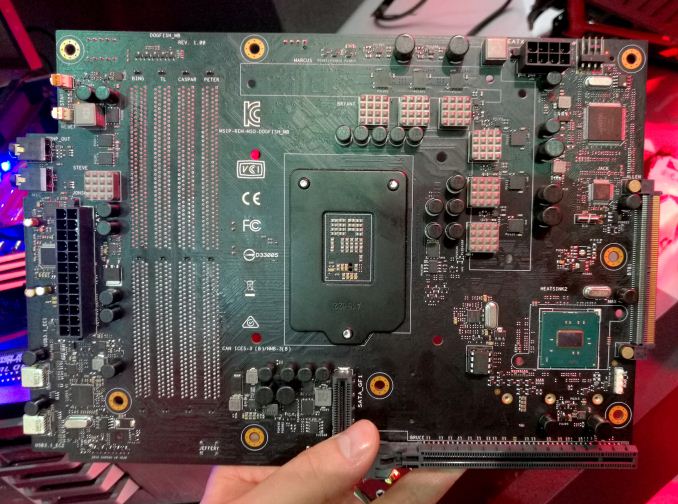
Click the image for the full resolution
Here we see more of what we know – power delivery chokes, a chipset, an 8-pin CPU power connector, a PCIe x16 connector and a 24-pin power connector. There are no SATA ports, and nothing on this system looks normal.
So, to explain: on the bottom near my finger is a custom connector, akin to a 4x PCIe connector, that breaks out into four SATA ports on a daughter board where are hot swappable on the chassis. The connector supplies both data and power. On the far right is a proprietary ASUS header for the rear IO.
At current, ASUS is not finalized on the pin layout and isn’t conforming to any particular standard, but this connector can send chipset PCIe lanes, digital video, and a few other things, over to a daughter board. This means one thing – adjustable rear IO panels!
I love this idea. Here are two examples of what ASUS suggests: the top one is a rear IO for workstation users, featuring dual Intel NIC and inside is a RAID capable M.2 slot running at PCIe 3.0 x4. The rear panel is a Home Theater focused design, using a single NIC and a USB 3.1 controller for 10 Gbps use. ASUS also had a VR edition with the specific ports required for the big VR headsets currently in the market. Because the custom connector carries enough PCIe, this opens it up to other custom designs, such as Thunderbolt, 10 Gbit Ethernet, different Ethernet/WiFi, additional storage, or anything that needs PCIe. Also, on the audio side, because this is a separate board, it could also influence audio capabilities and provide cleaner signals for audio processing. Adjustable rear IO is a topic only just being breached, with plenty of possibility.
Avalon's design is still very much fluid, with single GPU setups currently being supported:
In the video at the top of the page, we were able to get some hands-on time with Jonathan Chu, the product manager of Avalon, and do a quick teardown video after Computex had finished. Apologies for the audio, it was an impromptu recording with no extra equipment apart from a smartphone.
At this point the Avalon project is in an early design phase, so ASUS is looking for feedback with what they have so far. I don’t particularly mind if this ends up being an engineering concept design that never goes on sale (I’ve been pushing manufacturers to do more concept designs, similar to vehicle manufacturers at car shows), but the fact that ASUS are prepared to even attempt this is a good thing.


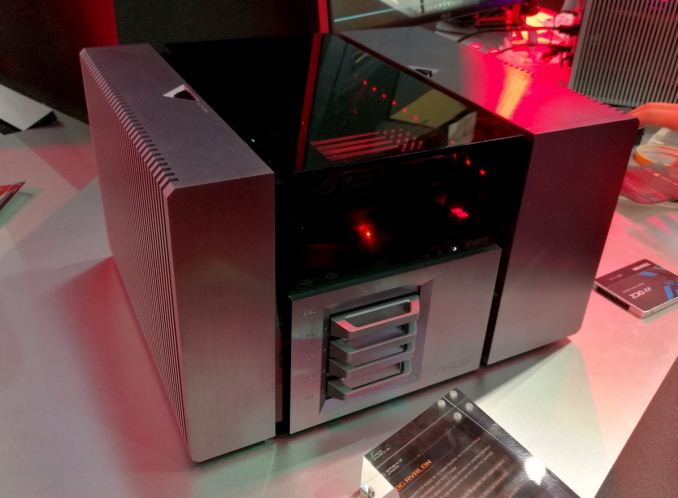
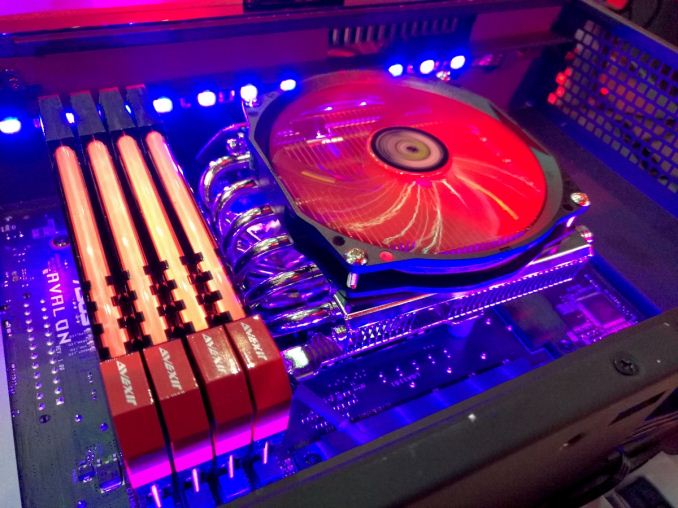
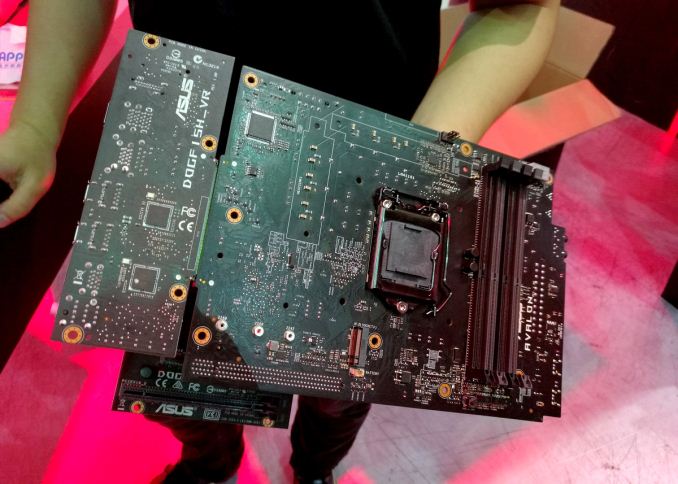

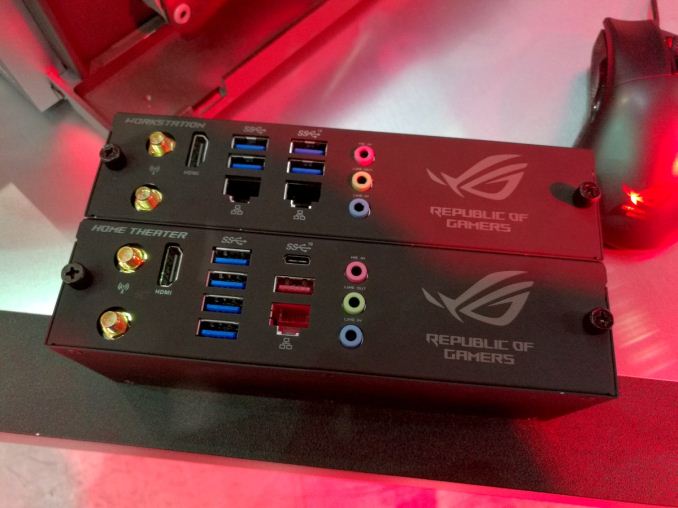
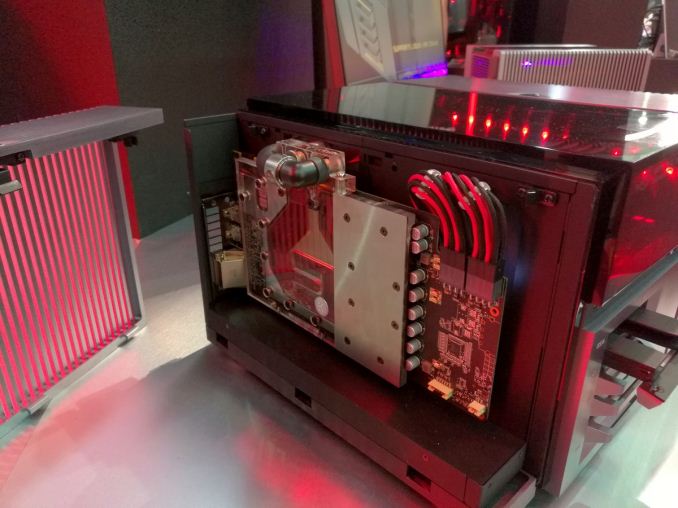








41 Comments
View All Comments
ClockHound - Friday, September 2, 2016 - link
That was my misplaced reply to the eery similarity to 80s hifi gear.Samus - Saturday, September 3, 2016 - link
Wow. That's crazy. I'm not so sure how comfortable I'd be dropping coin on something so radical and proprietary (hence why I don't own any Apple PC's) especially since it is unfortunately unlikely to succeed. It's just too many steps being taken at once. At least they kept standard ATX power connectors though...but in all honesty those are what really need to go.Most modern SERVERs with proprietary PSU's only run 8-12 pins to the motherboard and supply all the necessary power through eliminating legacy redundancy in the ATX specification and by using thicker gauge wire to carry more current. These servers have higher demands than desktops while generally using more powerful CPS's and PCIe controllers.
ATX specifications are a real burden on system integrators which is why there are so many modifications to it, creating proprietary motherboards.
doggface - Saturday, September 3, 2016 - link
My 2 cents. The most important consideration for htpc would be how small a space can you get a desktop i7 and gtx1080 into.To me, with such a proprietry system, the key is make an awesome cooling system that is near silent, fits in home theatre set up, and has a nice modern aesthetic.
Basically a ps4 but way more powerful. Being able to configure io back ports is more about Asus providing separate models for me to buy. I am not going to be plugging more than one in.
crashtech - Saturday, September 3, 2016 - link
At first look I thought the system would feature gigantic passive heatsinks. Perhaps a modification of their modular design could accommodate such a thing. A lower, wider stance (closer to a 4U or average HT receiver) and a TFX size PSU might allow for large heatsinks on either side; since the GPU is already off to one side, that part would be cake. The right heatsink could be heatpiped over to the CPU. That might make for a monster gaming/HTPC.danjw - Saturday, September 3, 2016 - link
I really love this idea! One thing that I didn't like is no air filters for the fans. This sort of system, being a bit of a puzzle to take apart and rebuild, could be a real issue for cleaning the system regularly. I also agree with Ian, that 10GBaseT port(s), would be a really nice option for the back panel module.Valantar - Saturday, September 3, 2016 - link
At first I was very skeptical of this concept (mostly given how fugly that case is and how oddly huge it seems for a compact system), but it's grown on me.-The interchangable I/O (with the option of routing PCIe there!) is pure genius.
-Stacking components is the way to go. Just look at the Dan A4 case or Ncase M1. This concept seems a bit too limited in terms of possible placements and orientations, but it's a start.
-Dual sided motherboards will add to complexity, but also utility. And $5-10 extra motherboard cost is cheap if it saves you from getting a $100 PCIe riser cable.
-More flexible solutions for todays smaller PCIe cards are desperately needed. Sticking an m.2 slot flat between your ATX mobo's PCIe slots is kind of dumb. Typical design afterthought. "Oh, let's just stick it there and call it a day."
-With motherboard support, a GPU riser could easily run two cards in x8+x8 mode - if the board supports lane splitting, it shouldn't even require a PLX chip, right? And with PCIe 4, this would effectively be PCIe 3 x16+x16, the gold standard for multi-GPU today. That would be true modularity.
But as a few others here have mentioned, several aspects of the ATX standard could do with modernization. Do we need 24-pin power connectors when nearly everything runs off 12V? Could PSUs be simplified by removing 3.3V and 5V altogether? How would standby power then be handled? Should support for PCIe lane splitting be required for spec compliance?
The moral of the story: Keep working on this, Asus. But PLEASE, work towards an open standard. A standard centred on modularity, customization, power efficiency, space efficiency and serviceability. That would be the way to make this a success. Any proprietary solution will be more stillborn than BTX ever was.
Sushisamurai - Sunday, September 4, 2016 - link
well, this looks nice - could have some aesthetic design improvements here and there, such as the CPU on front first and the DRAM in the back from a front to back view. Its a fantastic concept and I'd definitely buy as a home theatre PC. I'm not a fan of the 2.5" drive design, as i think the handles could be better concealed/foldable - why not have 3.5" drives with 2.5" adapters/caddys? The design as it stands would not match a home theatre device rack setup/aesthetic, but the concept is promising.Sushisamurai - Sunday, September 4, 2016 - link
if the price were to remain relatively close to a comparable HTPC SFF build of same quality (materials, aesthertics), then I would buy. Otherwise, current contendors for my HTPC builds are Corsair's Bulldog, or Corsair's 380T, budgeting $2000.deathdemon89 - Monday, September 5, 2016 - link
I'd buy this if:a) It isn't sold at too much of a premium from the traditional form-factor designs
b) It has space for traditional HDDs
RoninX - Thursday, September 8, 2016 - link
I like it! In particular, I like the emphasis on ease of use. I like that the motherboard and CPU are oriented horizontally, and the GPU and RAM sticks are oriented vertically, making it easy to insert, remove, and upgrade these components.The thing I don't like about tower designs is that you typically need to either plug in components sideways (which can be a pain to get all of the connectors to seat properly) or you need to remove all the connections and put the case on its side. At the same time, most horizontal cases are for HTPCs and designed for compactness and quiet operation rather than for high-end components and high-performance cooling.
I would seriously consider buying this, but only if ASUS is committed to sticking with supporting this form factor in the future. When Intel produces a new socket or chipset, I would want to be able to buy a new motherboard in the same form factor, rather than have to throw everything out.